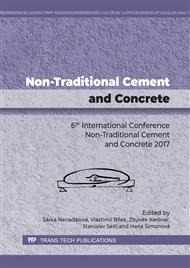p.131
p.135
p.144
p.148
p.152
p.159
p.163
p.169
p.175
Screening of Different Encapsulated Polymer-Based Healing Agents for Chloride Exposed Self-Healing Concrete Using Chloride Migration Tests
Abstract:
The service life of steel reinforced concrete in aggressive marine environments could be increased substantially by embedding a self-healing mechanism that ensures autonomous healing of cracks upon their occurrence. Previous proof-of-concept experiments have shown that the incorporation of encapsulated polymer-based healing agents (HAs) counts as a very appropriate way to achieve this goal. Over the years, several polymer-precursor-capsule systems have been developed in that perspective at our laboratory. Cementitious materials containing either commercial or in-house developed encapsulated HAs have been subjected to preliminary feasibility tests (water absorption, permeability tests, etc.). However, these experiments did not yet allow for a fast and straightforward assessment of the self-healing efficiency (SHE) in relation to the expected durability and service life performance of the material. This approach would have many advantages when having to select the most suitable polymer-precursor-capsule system for a particular concrete application. In this paper, a modified chloride migration test based on the one prescribed in NT Build 492 has been proposed to support the development of self-healing concrete for marine environments. Four polymer-based HAs have been screened that way, i.e. an in-house developed high-viscosity polyurethane (PU) precursor, a commercial low-viscosity PU precursor, the same commercial PU precursor with addition of accelerator and benzoyl peroxide (BPO), and an in-house developed 2-component acrylate-endcapped precursor + cross-linker. For now, a highly repeatable SHE value of 100% could only be obtained for the second option.
Info:
Periodical:
Pages:
152-158
Citation:
Online since:
January 2018
Price:
Сopyright:
© 2018 Trans Tech Publications Ltd. All Rights Reserved
Share:
Citation:


